Small, hand-built, and rugged RVs bring a new demographic into the fold
Mike Resch never expected to own a camper. He prided himself on his ability to live out of a backpack, and always thought RVs were “ridiculous on the road, ridiculous at campsites for the size. If you are going to the mountains, why not be outside?”
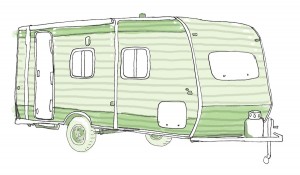
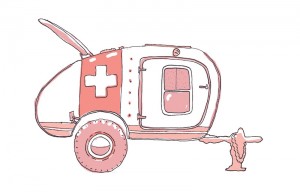
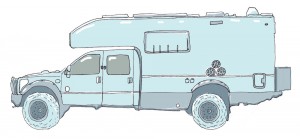
Then, last winter, with their second child on the way, he and his wife started looking for a bigger house in their hometown of Boulder, Colorado. Nothing was in their price range, but a neighbor had an aluminum-sided, 20-foot JayCo camper trailer for sale.
“He was retired and OCD, so we knew it would be in perfect condition. It was a great price,” Resch says. Plugged into water and electric next to their house, it serves as guest quarters. And over the summer they took it camping, too.
“Now we have a two-year-old and a three-month-old. We can still go camping and be outdoors,” he says. “We’ve gone to remote places along the Arkansas River. We like to kayak. We have a big dog. It works fine with our pickup truck.”
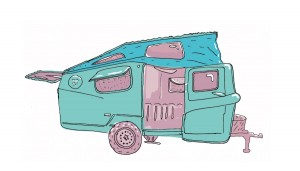
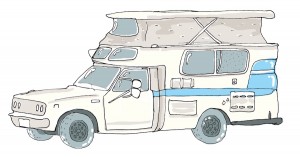
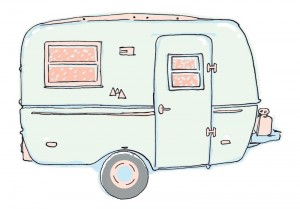
In the last 15 years, U.S. camper sales spiked, crashed, and spiked again, reaching new all-time highs as gas prices tumbled. Now, with thousands of models to choose from and new innovations every season, even those who thought they’d never own an RV can find a camper to fit their style. Camper ownership is no longer just for families and retirees. The expanding demographic trends present business opportunities for everyone from sales people and campground owners, to mechanics and carpenters. Especially in the rural west, with airports few and far between but camping spots aplenty, campers and motorhomes are the face of summer tourism.
![]()
I don’t own a camper, but as the years go by, more and more of my friends do. One drives a two-tone ’84 Volkswagon Westfalia pop-top Vanagon complete with a little stove, sink, and fridge. Another moved here from Philadelphia in a squat ’76 Toyota Chinook, white with a turquoise racing stripe and a bunk in the cab-over pop-up. Another, mother to 9- and 11-year-old boys, admits her family’s ’98 Ford Coachman van makes the spring- or fall-break excursion to the mountain bike trails in Fruita and Moab that much easier, not to mention quick overnight trips to the nearby national forest.

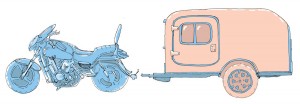
Last summer, two of my friends towed their 13-foot, ’78 Scamp up from Colorado behind their Subaru and parked it near a local climbing crag for an extended weekend. They’d acquired this egg-shaped contraption for free, diverting it from the landfill, and patched its fiberglass sides, scrubbed out the dirt and mold, replaced cabinet hinges, painted cupboard doors, and sewed curtains and cushion covers.
Seven of us piled into its small quarters after rock climbing one evening, including two-year-old Oliver, who, between mouthfuls of raisins, reenacted the incident of the bear that raided his trashcan. His mom boiled hot dogs by light of headlamp. The Scamp has a tiny fridge and sink, a two-burner stove, a closet, and sleeping quarters for three. There’s no toilet or shower, no TV or wifi. It doesn’t compare to the massive RVs cruising summer interstates like migrating whales. At the same time, it’s a world of luxury for a young family used to pitching a small backpacking tent next to the car for a night out of town.
![]()
These friends are part of a growing cadre of resourceful, cash-strapped people who salvage or buy retro campers for little to nothing. Such small, lightweight trailers are just an entry point at one edge of a huge industry that’s only growing. Carey Gabrielle is Sales Manager at Camping World of Longmont, a 65-acre RV dealership along I-25 on the Colorado Front Range.
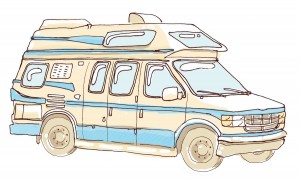
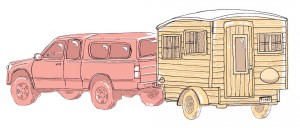
“Usually if there is a new family, they get a popup. Then they graduate to a trailer. Eventually they upgrade to a fifth wheel. And then when the kids are gone, they get a motorhome,” he says.
Camping World of Longmont, one franchise in a national chain with 116 stores, will sell 1,200 units this year, from tiny light-weight campers a small car can tow, up to the huge “diesel pusher,” a giant motorhome fancier and better equipped than many houses. And this is just one store. RV America (World’s Largest Indoor RV Showroom!) is ten miles up the interstate. In the opposite direction are Johnson RV, Century RV, Summit Adventures RV, Big John’s RV Sales and Service, Discount RV Corner, and Windish RV Center, to name a few.
Some buy campers as a way to save money, be it on real estate like Mike Resch or as a means to avoid hotel rooms and restaurant dining. Indeed, the RV Industry Association cites one report that found traveling by RV can be 25 to 50 percent less expensive than driving a car and staying in hotels. Still, the costs of buying and caring for a camper can add up. At Camping World of Longmont, 80 percent of those 1,200 units will be financed, with an average monthly payment of about $300. Campgrounds with RV hookups typically cost $25 to $50 per night, less than a hotel but rarely free. Then there’s gas, and motorhomes typically get only 8 to 10 miles per gallon, even less for the biggest ones. Another expense is storage.
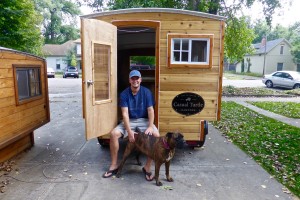
“Storage is typically $1 to $1.50 per linear foot per month. So if you have a 30-foot trailer, it would be about $30 to $45 to store,” Gabrielle says. “If you have a big diesel pusher and you want to store it indoors, that could run $300 to $400 per month. That is only about 5 percent of customers who store their RVs indoors.”
And repairs. Camping World of Longmont has a 24-bay service garage, with so much business June through October that they limit repairs to units purchased from their stores.
![]()
Camper sales have climbed slowly since the RV Industry Association started keeping numbers in 1980. Sales reached a peak in 2006, with just under 400,000 units available in the U.S. at $14.7 billion in value. Then Wall Street crashed, and the “expensive toy” industry took the hit hard. In 2009, the low point of the last decade, fewer than half as many units moved as had in 2006—only 165,700—and the retail value, at $5.2 billion, was just 35 percent of its peak. Since then, the numbers have climbed steeply back up. As of October 2015, not quite as many units had sold as in 2006, but the retail value is higher than ever at $15.4 billion.
RV owners are changing, too. “The demographic used to be 45 to 65 years old. Now it’s more like 28 to 75,” Gabrielle says. Campers are not just for sightseers. They’re for athletes and adventure-hogs, families and single people, 20-somethings (hashtagging #vanlife) and active retirees, and everyone in between.
![]()
To meet this diversity among RV enthusiasts, small camper manufacturing companies are starting up in backyards and home garages throughout the mountain West and thriving thanks to overwhelming demand for their products.
The smallest, lightest, and easiest-to-make campers are teardrops, and clever models abound. Start with Hiker Trailers, a boxy, low-cost teardrop manufactured in Denver and Indianapolis ($2,895 and up). Or Moby1 Trailers, with a model towable by motorcycle, built in Springville, Utah ($6,500 and up). There’s also Colorado Teardrops, available for sale or rental in Boulder, Colorado, since 2014 ($10,300 and up). Vintage Overland hand builds stamped-aluminum teardrops with rugged off-road tires in Grand Junction, Colorado ($10,500 and up). This list barely skims the surface.

To see one of these startups firsthand, I stopped by the Casual Turtle Campers “factory,” actually a tiny garage in Fort Collins, Colorado, to talk to Peter Pavlowich. He was putting the last coat of stain on the tenth camper he’s built since starting his business a year and a half ago. He studied woodworking in college and crafts these beauties one at a time in his driveway to the specs of each customer. The trailers are elegant and cozy, with wood siding and trim, and bead board and canvas interior details. Plenty of windows, no electricity or gas, light-weight. More sailboat cabin than RV.
“The roof design is maybe the most unique feature,” he said, referring to its domed, turtle-shell shape. “I started with an arc fore to aft, then tried port to starboard, and this is a combination of those two arcs. … I spent a lot of time on the computer designing it and making my mistakes there before I built it. … I like the roof. It’s good looking. It’s practical. It’s strong.”
He keeps the trailers and truck bed campers simple for people who’ll cook outside on a camp stove and don’t want to mess with gas lines, drains, plumbing, and winterizing. Most of his customers find him on the tiny house blogs, and several of them have been single women looking for something simple, small, beautiful, and easy to take care of. He represents just one entrepreneur making a go off the camper craze.
The options to a prospective camper owner are endless. Some are hip, like the colorful Cricket Trailer, designed by a NASA engineer in Houston, Texas, and set up for days off the grid ($15,495 and up). Some are chic, such as the popup Mercedes Marco Polo, which looks like a minivan on the outside, but with a white Euro-style interior and marketing materials featuring pro chefs cooking gourmet meals on the beaches of Sweden ($73,900 and up). Others are rugged, like the Ford F-550 4×4 EarthRoamer, which comes in three lengths up to super stretch and includes turbo diesel power, interior wood finish, a motorcycle lift, and ability to carry 85 gallons of drinking water for an extended backcountry excursion ($280,000 and up). People convert school buses, 15-passenger vans, Hummers, semi-trucks, Army trucks, ambulances, and more into campers. Those without the skills to make a camper themselves can have about any vehicle lifted, ruggedized, and camperized by custom camper mechanics.
The unit Camping World will sell the most of this year is an aluminum-sided 30-foot JayCo trailer with five beds and a full kitchen and bathroom. A regular pickup can tow it, and it will house a family for a weekend trip.
I can’t help but also ask Gabrielle for a tour of the fanciest camper on the Camping World lot. He leads me up the steps of the mind-boggling Entegra Cornerstone, and starts reciting its stats: 45 feet long, 50,000-plus pounds, 150-gallon fuel tank, turbocharged 600 horsepower engine, in-floor hot water heating, fireplace, washer and dryer, HDTV, leather sofa, high-gloss porcelain tile, quartz countertops, walnut cabinetry handcrafted by Amish woodworkers in Indiana, and the list goes on. This is a two-person dwelling, a true luxury home on wheels. The price tag is $650,000, and Gabrielle expects to sell four of them this year, maybe even one to somebody who graduated from a tent to a little trailer decades before.
![]()
It’s not possible to consider how outdoor recreation and tourism fits into the new West without touching on recreational vehicles. As the numbers at Camping World prove, all sorts of people want campers—not just retirees—and the price is worth it. Campers may be one of the best tools for getting the masses outdoors, or at least partly outdoors.
Mike Resch, the guy with the dog, kayaks, and two little kids, has been surprised by how much he likes his family’s camper. He’s even found staying in RV parks isn’t that bad. Often, the other visitors are inside, enjoying their air conditioning and satellite TV, leaving the riverbank or scenic views to Resch and his family. He’s also picked up a new unanticipated pastime: watching other RV owners back into or out of campsites.
“They don’t have experience backing up trailers. They just have money. These things are huge, especially the fifth wheels,” he describes. “You see people break things and run into things. It’s entertaining.”
Even those who think they don’t want an RV probably do, maybe for reasons they haven’t thought of yet.
Text by Emilene Ostlind
Drawings by Joe Walton
Emilene Ostlind edits Western Confluence magazine. More of Joe Walton’s illustrations can be found at joedoodles.com.



Hello and thank you for this article. Do you have any information on Peter Pavlowich and Casual Turtle? The website said they went out of business in 2016, but left open a possible return.
He did phenomenal work. Thanks for sharing any updates you may know.
Checking if anyone has been able to learn about Casual Turtle campers.